This is a Konica III, a 35mm rangefinder made by Konishiroku Photo Industries in Japan between the years of 1956 to 1958. As the name suggests, this camera is a third in a series of compact, solid bodied, 35mm rangefinder cameras made by Konishiroku. The entire Konica I, II, and III series was in production until around 1960 and was very popular both in Japan and export markets. The Konica III has a unique double stroke left hand thumb wind lever for advancing the film, which was thought to be faster than the traditional top or bottom mount wind levers.
Film Type: 135 (35mm)
Lens: 48mm f/2 Konishiroku Hexanon coated 6-elements
Focus: 3 feet to Infinity
Viewfinder: Coincident Image Coupled Rangefinder with 48mm Projected Brightlines
Shutter: Seikosha MXL Leaf
Speeds: B, 1 – 1/500 seconds
Exposure Meter: None
Battery: None
Flash Mount: Coldshoe and M and X Flash Sync
Weight: 737 grams
Manual: http://www.cameramanuals.org/konica/konica_iii.pdf
History
The Konica III was the third variant in Konica’s (then known as K.K. Konishiroku) line of successful fixed lens 35mm cameras which were sold between the years 1947 through 1960.
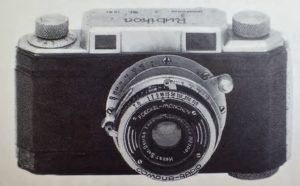
The original Konica I was based off a pre-war prototype that Konishiroku’s then subsidiary Rokuoh Sha had started to develop in 1938 called the Rubikon. The Konica I shared many of the same design elements of the earlier Rubikon including it’s angled corners, knob wind, viewfinder and rangefinder design, and collapsible lens/shutter tube. The Rubikon was never offered for the consumer market and only 2 prototypes are known to have been made. The image to the right is from Hishida Kōshirō’s 1986 book, “Konica history 10. Sengo no kamera.” and shows this same prototype with Compur-Rapid shutter and Hexar 5cm f/3.5 lens.
Work on the Rubikon would be halted around 1938 due to the Japanese military’s need for military aerial cameras, which Konishiroku had experience building. A variant of the Rubikon would be sold for X-ray photography using the camera’s same basic shape, but without a lens or shutter mount. This camera would be called the Rubicon (with a ‘c’) and although still extremely rare, does show up in private collections from time to time.

After World War II, Konishiroku would resurrect the pre-war Rubikon and make subtle changes to the bottom plate, adding a tripod mount, and offering the camera with Japanese built Konirapid shutters instead of German Compurs. The camera’s name would be changed to “Konica” which was an amalgam of the name “Konishiroku Camera”. In the first half of the 20th century, Japanese manufacturers had great admiration for German camera designs, often employing German designers to help build their own cameras. It was common for these Japanese camera makers to give names to their camera’s that took a cue from German brands like Leica who shortened a part of the companies name and added the -ca suffix to the end.
The original Konica was released in 1947 and was an entirely Japanese design, which was a departure from other Japanese makers at the time like Canon and Nippon Kogaku (Nikon) whose models were highly influenced by German models.
The Konica was very popular in the Japanese domestic market and was a source of pride as the world’s first Japanese designed and Japanese made camera. The camera received several minor upgrades over it’s first few years, including faster f/2.8 Hexanon lenses, better shutters, flash synchronization, and general build quality improvements.
In 1951, a heavily redesigned model called the Konica II was released which offered upgrades such as a fixed lens mount, top plate shutter release, double image prevention, and an accessory shoe. The base lens on the Konica II was a 5-element f/2.8 Hexanon lens that compared favorably to similar lenses made in Germany at the time.

The Konica II was available in a couple of different variants depending on the lens and shutter combination of the camera, in the ad to the right from the November 1954 issue of Modern Photography, the price of the top level Konica II was $119.75 which when adjusted for inflation is a little over $1100 today, making it one of the more expensive Japanese cameras of the time.
In 1954, an experimental prototype called the Konica FR was shown based off the Konica II, but with an interchangeable front lens element. The design was reported to be similar to Kodak’s Retina series in which the rear lens grouping would remain fixed in the camera, and the front could be removed and swapped out for a wide angle or telephoto lens, changing the effective focal length of the camera. The camera never went into production, likely because of the cost of the system and the increasing popularity of the SLR which was quickly gaining popularity around this time.
The Konica II series was in production until at least 1957, a year after it’s successor, the Konica III was released. The Konica III offered a significant improvement to the Konica II and was sold as a premiere camera both in Japan and for export.
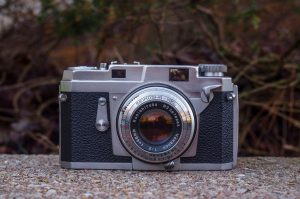
Although the Konica III offered better lens and shutter combinations, a larger and brighter viewfinder, and a self-timer, it’s most distinctive feature is the left handed “thumb wind” film advance on the front of the camera. The Konica III is the only camera I know of that uses a film advance like this. Around the time of the Konica III’s release, many manufacturers were experimenting with alternative ways to wind the camera. Many had bottom film advances like Kodak and Canon, others chose a trigger wind system like Ricoh and Leitz, but Konishiroku’s thumb wind system was unique.
The idea behind this system was that by using the photographer’s left thumb to press down on a lever, the camera could be wound without ever having to remove the camera from the eye. The thumb wind system was a double-stroke design, which means that in order to fully advance the film and cock the shutter, the photographer needed to press down on the lever twice. It’s a polarizing design today, with some people loving it and others hating it. Although I could not find any period reviews of the camera, I have to guess that people felt just as polarized about it back then.
At a price of $124.75, the Konica III was one of the most expensive fixed lens rangefinders on the market. When adjusted for inflation, that is like $1147 today, putting it out of the price range of the non professional. The advertisements below are all from 1956 and 1957 and show how the camera was marketed.
After it’s release the camera would receive two pretty significant upgrades, one called the IIIA and the last the IIIM. The IIIA had a much larger viewfinder with projected frame lines and a 1.0x magnification factor allowing the camera to be used with both eyes open for super quick composition. The IIIM added a unique flip–up coupled selenium exposure meter and half frame capability.
Although very capable and well built cameras, the IIIA and IIIM were the poorest selling of the entire Konica series likely due to the expensive price and the continued rise in popularity of the SLR. While rangefinder cameras would remain a viable product for at least another decade, they were increasingly offered as entry level cameras for novice photographers. Professional and advanced amateur photographers were less and less interested in rangefinders, no matter how good they might have been. The Konica III series ceased production sometime in 1960.
Today’ the entire Konica rangefinder series is popular with collectors with the later versions being the most desirable. It is not unusual to see good condition IIIA and IIIM models selling for a couple of hundred dollars. Even poor condition IIIs can approach $100 in questionable condition. A combination of excellent optics and build quality, along with the unique thumb advance make for a desirable model as shelf queens and shooters alike.
My Thoughts
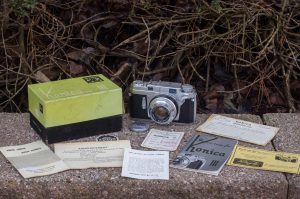
All of the Konica III models had been on my watch list for quite some time. The IIIA with the larger viewfinder and the IIIM with the flip up meter are some of the more desirable cameras in Konica’s lineup, so finding one of those for a good value was likely not to happen. So when I stumbled upon this Konica III in really nice cosmetic shape in it’s original box and with all of the original literature for a great deal, I had to snap it up. There was just one problem, it didn’t work.
I was prepared for what I assumed would just be a shutter flush, but when I got the camera, I had noticed that one of the iris blades was damaged and I couldn’t get it to close. I still flushed the shutter with naphtha to get it working correctly at all speeds, and for the most part, everything was working smoothly and by design, except now I had a “teardrop” shaped iris. It became more of an issue at smaller apertures, but wide open and near wide open, you couldn’t even tell.
I didn’t take any photos of the repair, so I have nothing to show you, but once I got the shutter cleaned up, everything worked fine, and I put the camera in the queue for it’s first roll of film.
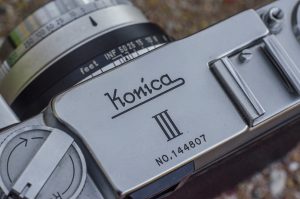
The first thing that likely anyone notices when they pick up a Konica III is how heavy it is. If there ever was a “heavy metal camera” this is it. Whenever I hold the Konica III, I feel like I should listen to Pantera’s “Fucking Hostile” or maybe some early Machine Head… “let freedom ring with a shotgun blast!”
Like most cameras made in the 1950s, the entire body is made of chromium plated brass. But unlike other 50s rangefinders I’ve handled, there seems to be some extra metal in there as this camera is really heavy. Weighing in at…
Edit: As I typed the above paragraph, I had the Konica III in my hands and it’s weight had left a constant impression on me. But then I pulled out my trusty kitchen scale and found it’s weight to be 737 grams which is nearly identical to a Yashica Electro GS at 735 grams and less than an Argus C3 Standard at 766 grams. I realized that this camera’s weight was really not that unusual.
I started to wonder why this camera seemed heavier than most others, when in reality it wasn’t. Perhaps it’s the compactness of the camera. Although I did not open up the camera, it feels like there is no wasted space inside of the body. The top plate is shallower than other 50s rangefinders like the Aires or pretty much everything made by AGFA. It seems the high build quality and compact size of the camera gives the illusion of the camera feeling heavier than it really is.
In terms of ergonomics, the most obvious starting point for this review is in the left handed film advance lever. Unlike other cameras like the Ihagee Exakta or Ricoh 519M that use left handed wind levers, the Konica III has a very unique lever system that is most naturally activated by the photographers left thumb. The camera can be held in both a landscape and portrait orientation with your left thumb on the advance lever, but only if you rotate the camera counterclockwise with your thumb on the bottom.
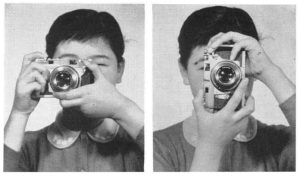
Strangely, the Konica III’s user manual has two images showing you their recommended way of holding the camera, except when held in a portrait orientation, they do it with the advance lever near the top, requiring a mangled mess of fingers to properly grip the camera. I can honestly say, never in my life have I held a camera like in the second image on the right. I can see no logical reason to hold the camera this way, especially when it is far more comfortable to hold the camera like in the next image.
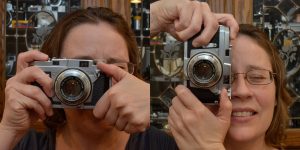
Had a camera like the Konica III came out today, or even in the decades that followed it’s release, the position of the film advance would have been seen as a gimmick. Before making any final judgement however, it’s worth noting that in 1956, the placement of controls on 35mm cameras was not yet cemented in stone. Manufacturers were still experimenting with what worked and what didn’t. Companies like Canon, Ricoh, Pentacon, and even Leitz would release bottom and left hand wind cameras well after the Konica III, so doing something different certainly wasn’t bad, but unlike cameras like the Ricoh 519M with it’s “Trigger-Matic” bottom wind lever that works remarkably well, I feel the Konica III’s implementation leaves a lot to be desired.
I won’t go as far as to say I hated the position of the wind lever, but it took a lot of getting used to, and even after shooting 2 rolls of film in the Konica III, I never had that “a ha” moment like I did with the Ricoh where I saw the benefit of it. I can certainly give Konica credit for trying something new, and I am sure there are those out there who will disagree with me, but I think the fact that after the Konica III series, Konica, and no other manufacturer ever released a film advance like this, more people agreed with me than didn’t.
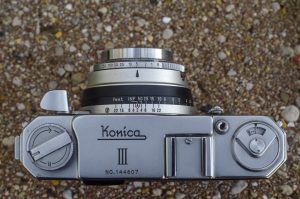
Moving beyond the wind lever, the camera is very handsome. The pebbled black leatherette body covering is perfectly applied with absolutely no sign of shrinkage or peeling which is so common of other cameras of the 1950s and 60s. There are no visible gaps between the top or bottom plates, and there is absolutely no play in the lens or any of it’s rings. The camera does not creak or make any noises suggesting of cost cutting somewhere inside of the camera.
The rest of the controls on the Konica III are pleasant and well thought out. The lack of a wind lever on the top plate means that there is more room for a large and elegant Konica III logo. From left to right is the film rewind knob, accessory shoe, shutter release, and automatic resetting exposure counter.
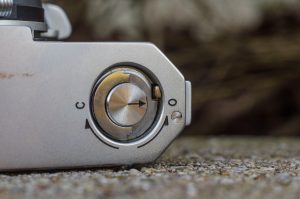
The bottom of the camera has the rewind button, tripod socket and the door release which requires a bit of explanation. The Konica III has a similar “Leica” style rotating lock that was common on many cameras from the 1930s through the 1950s in which photographers would load their own film into reusable film cassettes. Upon turning these dials to open the camera, they would rotate the film cassette closing the opening to prevent it from being exposed to light. Unlike other cameras however, when you fold open the lock and rotate it 180 degrees, you must then fold it back town again to activate the door release which you can see in the image to the left. It is possible to shove your fingernail in there without rotating the lock and still open the camera, but that wasn’t how it was designed to work. I think this system helped minimize the chances of the camera being accidentally opened with film it, but I also predict that this stumped many a user of these cameras who didn’t have access to the manual or instructions on it’s use.

The film compartment is typical of other 35mm cameras with the film traveling from left to right, but unlike other mid-50s cameras, Konica designed the take up spool to have 4 different notches to ease loading. Simply slide the film leader into the most convenient slit, wind the camera and close the door and you’re done. It’s not quite as simple as the auto loading systems that would come decades later, but it worked really well.
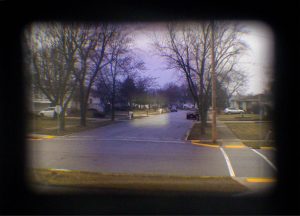
The viewfinder of the Konica III is on par with many other 1950s rangefinders, but not as gloriously large as the Leica M3 or the later Konica IIIA or M that would follow it. I had no problems seeing the whole image with projected frame lines while wearing prescription glasses. The rangefinder patch has a purple “contrast” patch that surrounds it, boosting contrast compared to the main part of the viewfinder. I find these types of contrast patches used by companies like Konica, Minolta, and others to be a huge help and wonder why everyone didn’t do it back then. The viewfinder is not parallax corrected and only offers parallax hash marks for close focus composition.
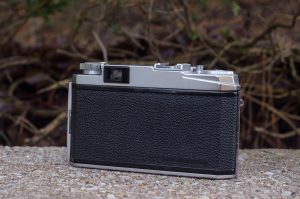
There is a lot to like with the Konica III. I would love to one day have the opportunity to shoot a Konica IIIA or M, but just because it’s the “base level” III-series, doesn’t mean this model is somehow lacking those later variants.
While not as large as the later models, the viewfinder in the III is more than adequate. The rangefinder patch is bright and easy to see. The 6-element Hexanon lens is as good as anything else out there. The build quality is second to none. This is a great camera that offers you absolutely everything you need to shoot amazing photographs in a compact and easy to use form factor. Simply, the Konica III is every bit as good as it’s later variants, and should in no way be seen as a lesser model.
My Results
My first roll of film through the Konica III was slow speed “Mr Brown” black and white film rated at ISO 6. This film is described by the Film Photography Project as a high contrast and low grain film that is very thin and easy to scan. I had never shot a roll of film with a speed of 6, so I used Sunny 16 with the Konica set to a shutter speed of 1/60 and the iris with 3 stops of overexposure.
Since there was a chance these shots might not have come out, I split a roll of Fuji 200 color film between this and another camera that I can’t remember what it was! The gallery below represents some of the better shots from both rolls.
I haven’t had as many opportunities to shoot with Konica cameras as I would have liked given their reputation as a quality Japanese maker in the 20th century. To date, my only Konica branded camera I have reviewed was the horrible Konica AiBorg which has the unfortunate distinction of receiving the lowest rating of any camera I’ve ever reviewed (or likely will ever review as I can’t image anything worse). I know that the AiBorg isn’t representative of Konica’s legacy, so it was with welcome arms that I was able to review this Konica III.
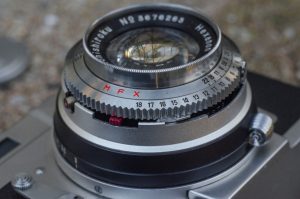
As is the case with most other premiere Japanese makers, you expect outstanding image quality from the 6-element Hexanon lens. As expected, the images produced by this camera are outstanding. They’re sharp across the entire frame with no vignetting, color fringing, or sharpness fall off near the corners. These images could have been shot by any other number of quality Japanese or German camera makers and you’d never know the difference simply by looking at the images themselves.
Obtaining accurate focus was a breeze as every image shot on both rolls of film came out properly focused as I had intended them to. Exposure was easy despite this being a fully mechanical camera and that I shot two very different kinds of film.
Up to this point, I have what seems to an excellent camera that I should be looking forward to shooting again, right? But I’m not, and even more frustrating is that I cannot put my finger on why.
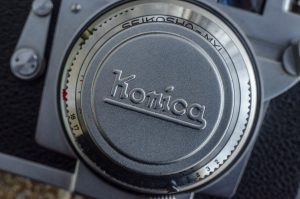
The Konica III is a technically excellent camera with a high level of build quality, and one that I had no problem getting great images from, but there was something missing from the shooting experience that left me indifferent to it after putting it down. The two different rolls of film in the gallery above were both shot in the summer/early fall of 2017, yet as I type this, it is March 2018 and this review has sat in draft form for months.
I’ve spent quite a lot of time trying to decide what it is about this camera that I didn’t love. Maybe it’s the awkward double stroke thumb wind film advance. Maybe it’s that on paper, I should have loved this camera and it’s reputation left me wanting more. Maybe that God-awful Konica AiBorg tainted me so deeply that I couldn’t look past the Konica name.
Whatever the case, I don’t expect many people reading this will agree with me, so I’ll stop rocking the boat and end this review with the words I had hoped I would have said all along. The Konica III is a well built example of a 1950s rangefinder with an excellent lens, an adequately large viewfinder with an easy to use and contrasty rangefinder, and a shutter that is dependable and capable of perfectly exposed pictures shooting Sunny 16. The IIIA and IIIM models are more expensive and slightly more desirable, but as long as you can live without a larger viewfinder or a selenium cell light meter, then the Konica III represents a heck of a bargain.
My Final WordHow these ratings work |
The Konica III is a great camera. It has an excellent lens, the fit and finish is outstanding, the viewfinder is bright and easy to use, and although I didn’t love the unique film advance, it clearly did not impede my ability to get great images from it. I am sure there are those out there who will tell you that this is one of the greatest cameras ever made, but I am not one of those people. I felt the shooting experience left a bit to be desired, and after shooting my first two rolls in it, I have never felt that sense of excitement like I have with many other cameras where I look forward to shooting it again. Still, don’t let my general ambivalence towards this model stop you from trying one out yourself. When you have a collection as large as mine, you can’t love them all! | ||||||
| Images | Handling | Features | Viewfinder | Feel & Beauty | History | Age | |
| 2 | 1 | 1 | 1 | 2 | 0 | 30% | |
| Bonus | none | ||||||
| Final Score | 9.1 | ||||||
Additional Resources
http://camera-wiki.org/wiki/Konica_(I),_II_and_III
https://johnnymartyr.wordpress.com/2017/07/03/behold-the-konica-iii/
http://www.photosafari.com.my/articles/konica-iii-a-well-made-camera-of-the-1950s/
https://filmosaur.wordpress.com/2013/08/17/meet-the-camera-konica-iii/

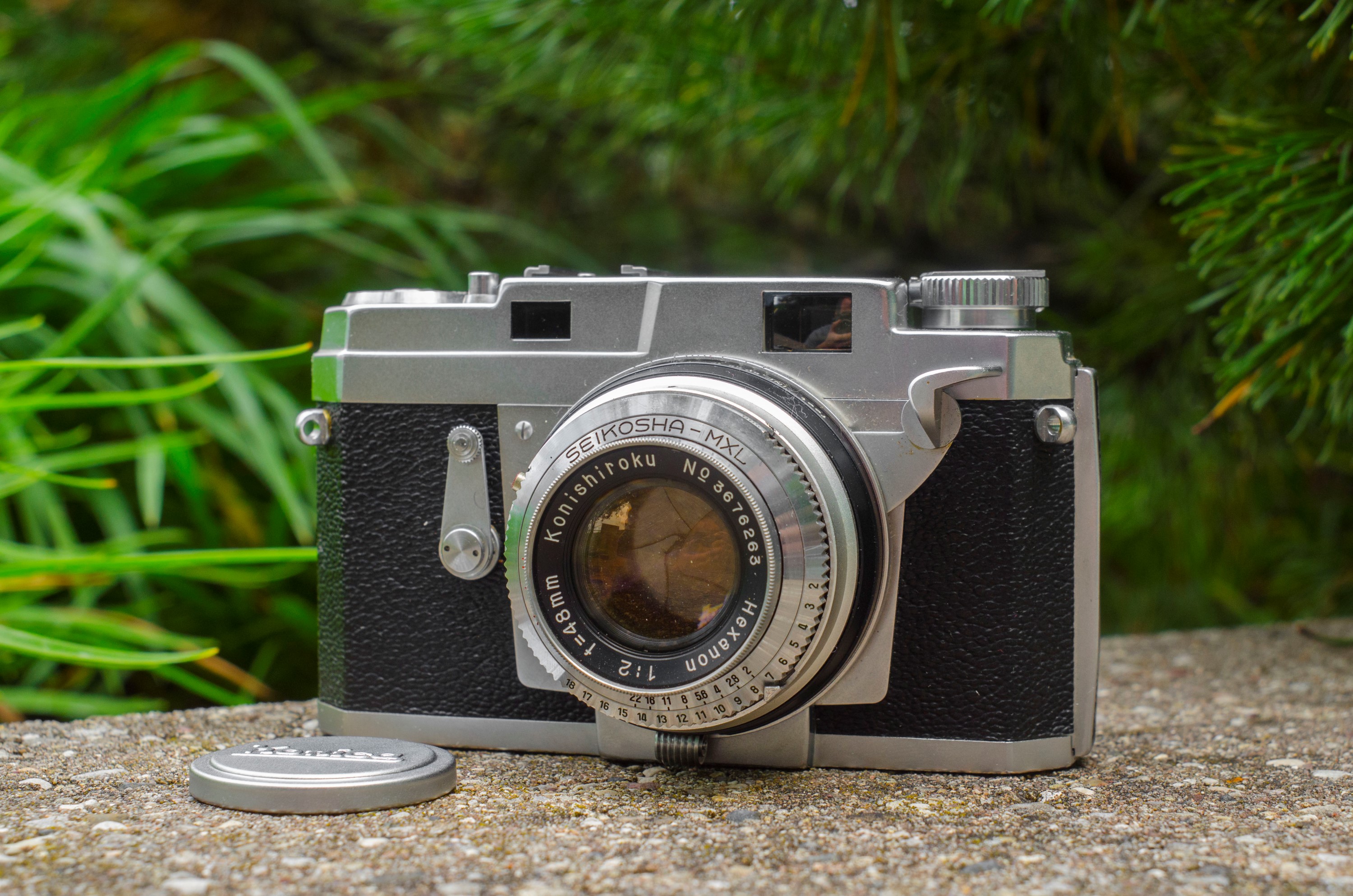
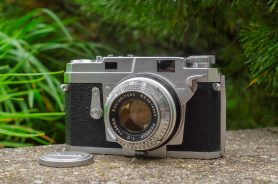
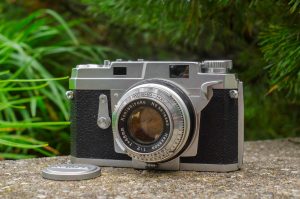
















Hello.
Superb camera,Konica III A real jewel, they are almost not found.
Best regar.
Dimitar.
Another great review! These are wonderful machines, with as you say, superb build quality. Feels like a Rollei, in a way – though they are entirely different sorts of cameras. The great thing about the IIIM is that it can shoot both full and 1/2 frame. Konica must have thought this important – some Autoreflexes can do it to.
The film advance is similar to the Zeiss Ikon Tenax and postwar Taxona cameras. Great article again Mike, always a joy to read your adventures with these lovely old machines.
I have a III and a IIIa, and I completely agree that they are a bit difficult to shoot with. I had no problem with the left-hand film advance, except that it means there’s no advance lever on the right to hook your thumb under. Plus the camera is heavy (or dense…normal weight but small) and the right side of the camera is tiny and slippery and offers nothing to get ahold of.
My right hand eventually cramps up from squeezing.
The results, though, are so good that I’m not giving up. A DSLR-style grip on the right side would help a lot, and I’m going through my junk box, looking for a bolt-on grip that I could modify to fit.
Plus it just occurred to me that a thumb grip like the ones they sell for the Fuji X100 (the ones that lock into the accessory shoe) might help too. They’re expensive, but I already have one and I’ll give it a try.
I love old cameras, but I think it’s odd that until about the 1980s, nobody seems to have given the slightest thought to making them comfortable to use. A little bump here, a little thumb grip there costs nothing, but it doesn’t seem to have occurred to the designers.
Kodak Retina folders are particular offenders. No room on the right side and nothing to hold on to.
Anyway, you’re right. The Konicas are exquisitely built, have amazingly good lenses, and just aren’t much fun to use.
Thanks for the compliments Scott. It’s also refreshing to hear that I wasn’t the only one who just didn’t fall in love with the Konica III. It’s one of those cameras that’s great on paper, but it just doesn’t add up. Still, I”m happy to have it in my collection and it makes great shots!
Mike, I’ve read your review 3-4 times. I like it very much, I keep going back to it for more. I bought one and had it out for cleaning and adjustment. I have 200 bucks into it so far. What I would like to get is a lens cover for it..any ideas? The plan for the camera is ‘street’ work in B&W.
Randy, I am glad you are happy with yours! It is a really neat camera and comes with a great lens! I believe the lens cap is a 38mm slip on but Im not 100% sure. Mine came with the original Konica cap, but I just checked and it has no markings on it.
Thanks for the backlink and an amazing write-up of these Konica RF models!
I found my Konica III in a thrift store in a little town in East Texas, complete with original brown leather case and lens cap, for $50 (about £25). It had belonged to the thrift store owner’s father, and she had fond memories of him using it from her childhood. It was very well looked after.
I live in England, but was in Texas as that’s where my father-in-law lived, though he was actually not much longer for this world, and passed away a few days later from a long-fought illness. I saw the thrift store owner at his funeral.
I brought the camera home, desperate to try it out (there was no place to buy 35mm film in the little Texas town), but before I could get a roll in it, something went wrong.
The shutter had been a little sticky when I first got it, but if it got stuck, I could just fiddle with the ISO or aperture and it would get going again. This issue would occur if I left the camera alone for more than a couple of days without trying out the shutter, but I could always get it to work again by fiddling with the settings, until one day I couldn’t.
One day, from out of nowhere, the winder went limp. It just wasn’t catching anymore. So I’ve never had a chance to try a roll through it, though finding this review (through Kosmofilm’s recent post about the best photo blogs) has made me really wish I had, and just might make me stump up the £50 to get this repaired (there is a guy here in the UK who repairs old Konicas).
I love the design, the heft and the feel of the camera. I don’t own many things from the ‘50s, and the Konica III feels like a journey to a hitherto unknown, impossibly well made and stylish past.
Thanks for your review, Mike. I’ll let you know if I ever get my model sorted.
PS – a few months later, the lady from the thrift store mailed me (via my mother-in-law) the instruction manual for the camera that she’d found in the interim, itself a beautiful piece of ‘50s design. And I agree, the way that lady holds the camera is ridiculous 🙂
Great story Nick! Thanks for sharing. Its not often that I acquire a camera and know anything about it’s previous owner so it’s great to have a connection with yours like that. It really sucks though to hear that the camera stopped working. Something that is true of many cameras, not just the Konica III, is that the longer they sit, the more likely they are to break. In hindsight, you cold have possibly alleviated the shutter issue with some naphtha, but that doesn’t always work.
If you have the option of getting it fully repaired for only 50 pounds, then I absolutely recommend you do it! CLAs of cameras like these in the states are usually in the $150 – $200 range, so to get the camera working again for that amount is a no brainer! Not to mention, in working condition, you’ll love shooting it!
Thanks Mike and Randy! Well, after I wrote this post, I fiddled with the camera some more and got the shutter to fire again. It turns out the winder crank still works, it just doesn’t ping back up each time, I guess the spring has gone, but after reading both of your replies, I decided to put a roll of Ektar 100 through it, and see what happened, and it worked like a dream! A couple of shots went awry, due to the sticky shutter, but most turned out lovely! I’ve put a few on flickr here –
https://www.flickr.com/photos/warmseas/albums/72157679633667168
Now I just need to brush up on my manual photography skills and shoot it some more! Mike – if I were to try some naphtha on the shutter (would lighter fluid work?), is it just a case of squirting a tiny amount on, and firing the shutter a few times to help lubricate it, or would I have to take anything apart? That I wouldn’t be too confident to do, but it seems fairly usable even as it is, I only lost about 6 or so shots from a roll of 36, and the more I use it, the more it seems to want to come back to life. Thanks again for your encouragement, guys!
Nick, I too encourage you to get the Konica repaired. I have the IIIA bought at an auction for a thrift store. While waiting for auction day I found a fellow to repair it. Although it was pristine, at 50 years old something was likely out of kilter. The ‘CLA’ was $120 cad. I have learned that the shutter blades can be an issue. Mine is up and running and waiting for spring so I can get out and do some street shots in the ‘big city’ close by. Pick up your camera, feel it’s ‘heft’ and pretend that is working fine, look through the viewfinder, and say to yourself ” I’m going to get this fixed”. Please don’t tell your spouse that I said that..or you can throw me under the bus and blame me. Happy shooting!
Thanks, Randy – see above! ^^
I had a IIIa that was serviced so that it worked perfectly. Unfortunately i never really enjoyed using the camera, even though the images were excellent. So I sold it on eBay. I much prefer shooting with my Nikon SP.
I felt the same way about my III. Like you said, the images it makes are great, but the user experience never did anything to me. I have not touched this camera since I published this review in early 2018.
Yea but It’s $1,000 for the Nikon SP compared to the $100 dollar Konica III.
You’re not wrong! 🙂
I have a Konica 111 camera that I bought on E-Bay about 20 years ago; I don’t recall the price. It is the original 1956 model with the Konishiroku shutter; in 1957, when the Exposure Value system was introduced, I believe that was when the Seikshoka shutter (pardon the spelling) was introduced. I only use it a couple of times a year, shooting colour slides exclusively, mainly as a backup camera on vacations. The 1/500 of a second shutter speed seems slow, but allowing for that when shooting (cutting down the exposure) solves that. I should have it given a CLA but can’t really justify the expense, as long as i keeps working. The shutter advance spring seems to be on its last legs. I love the solid quality of the camera and as noted the lens is fine. I note the prices on E-Bay are all over the map. I hadn’t realized that lack of use could cause issues. I enjoy using the camera.
Great story, Jo! I am happy to hear of someone enjoying these wonderful cameras on a regular basis. You are right, lack of use is the number 1 killer for old cameras so keep that thing shooting as long as you can!
I have my grandfather’s Konica III (No. 120507).
It is in excellent condition. I’ve had it sitting in a place of honor on a shelf. This article inspires me to go out an get a “real” roll of film again and take some non-digital images.
Thank you!
Glad to hear it! These old Konicas are capable of excellent shooters and if your grandfather’s camera is still in shooting condition, you should definitely load in some film!
Great article, Mike. While I don’t own a model III, I do have the IIIA, along with the IIA, the I, and the IIIM. I absolutely love the IIIA and the IIA. The unusual film advance doesn’t bother me, as I also like the “periscope” advance on the Voigtlander Vitessa, as well as the double-stroke Leica M3 and Leidolf Lordomat cameras. I found the IIIM in practically unused condition a few years ago, complete with the original box, case, instructions, warranty card, and the ultra-rare half-frame mask (unused in its original cellophane and plastic case). Since I love half-frame, I intend to find someone to do a CLA (and remove the horrible EV lock, which I also had removed on my IIIA). I’ll probably also have the repair person remove the flip-up selenium meter, since it isn’t working anyway. I love these Konica rangefinder, and I ink they are real “sleeper” bargains, even today. Cheers.
I owned a Konica III when I was in my 20s and very much into photography. I loved the camera, and especially loved when I saw it being advertised in photography magazines, with the slogan, “The lens alone is worth the price.”
Alas, I was soon lured away by a new Minolta SRT 101, and sold my Konica III to a friend.
Just acquired a IIIA in great condition. The export model which had the 50mm f1.8 lens. There is some disagreement on this – some say it is sharper than the 48mm, some not. Time will tell.
I was lucky. Mine not only came with the case which is rather well made (metal film reminder dial on the back) but also with the Konica shoe mount light meter (working), lens cap and (drum roll) the tiny screw in trigger soft release which is almost always long lost by people screwing it out to use a cable release. Wonderful viewfinder. But the LV/EV exposure lock is problematic. I have no trouble with the concept – it is an early form of Program mode and was designed to simplify things, especially with a separate or uncoupled meter which is why so many old meters have EV numbers. But it simply bewildered most people, hence its short life.
It is quite difficult to set on the Hexanon and to adjust with my arthritic fingers – you depress the black aperture ring using the two raised and knurled adjustment grips. But it is a small and awkward adjustment to shift the EV program/number. Yes, they are underneath but that matters not because to unlock the damn ring, upside down is perhaps the best grip. It requires some thought and effort, even for the less challenged. You need to have it set up for the most common range of shutter/aperture combinations – most of us rarely use the very slow speeds and very small apertures anyway, except in special circumstances. Then the selection of the usual speed and aperture combinations is quite quick.
And a supporting comment about the Aiborg (you will NOT be assimilated). it’s actually a remarkably well featured camera and a desperate attempt at a unique user interface. But concealed in what I’ve long argued is the ugliest camera ever conceived or made. Darth Vaders helmet. I imagine the marketing department meeting – “How can we we make it worse? I know! Glitter!” Yes, the black plastic top cover is semi-translucent with a subtle glitter incorporated. Awful. I did encounter one of the very rare working survivors and got some decent image out of it – and great laughter from those around me. Ugliest camera ever – by a mile. Please do a test on it if you can find a worker – that would be fun.
Having had a Konica I, II and IIIA, I can honestly say as much fun as the lever wind and bright 1:1 viewfinder is on the IIIA, my favourite is easily the Konica I
I picked mine up locally for about US$65, it dates from 1949 (right at the end of the “Made in Occupied Japan” era) and by god it’s fun to use. The viewfinder is small but the rangefinder patch is super bright and contrasty, and the whole thing just feels like it’s hewn from a solid piece of metal. Super duper basic operation, but it’s just so lovely to use. Very easy to do accidental or intentional double exposures though as the shutter is mechanically separate from the winding.
I put a 20 year expired roll of HP5 through it and loved the results, will give it a go with colour film next time, maybe a fresh roll of Kodak Gold. Here’s some sample pics: https://imgur.com/a/r4TKADX